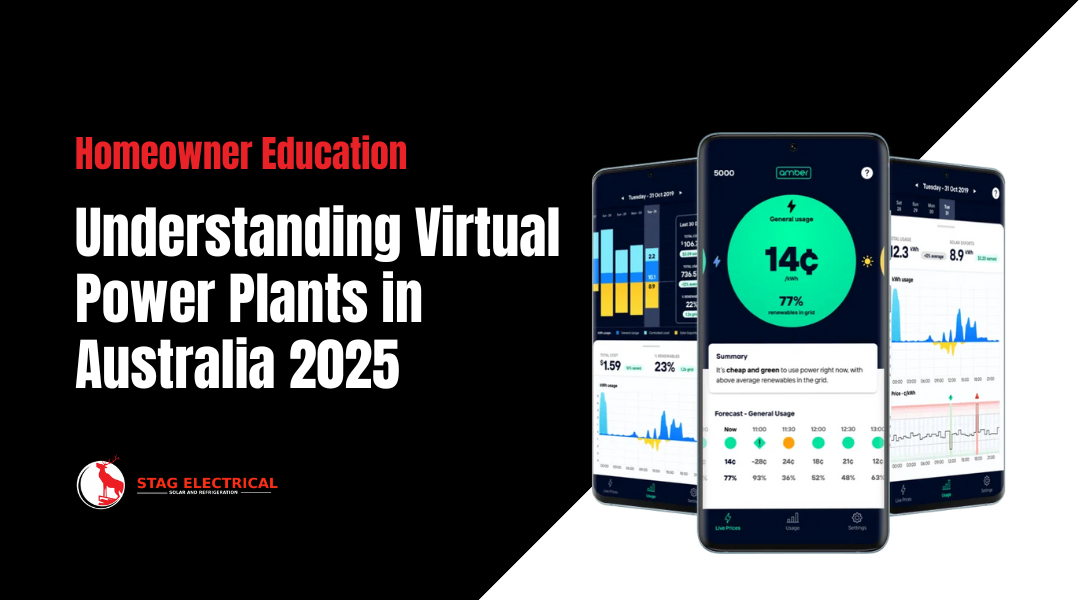Virtual Power Plants (VPPs) are changing how Australian homeowners interact with their solar and battery systems. Instead of simply storing excess solar energy for home use, VPPs allow your battery to contribute to a larger network, providing grid support and potential financial benefits. As more households install solar panels, batteries, and even electric vehicle (EV) chargers, understanding VPPs is essential for maximizing your energy savings and future-proofing your home.
This guide is designed for homeowners who want to know:
- Whether a VPP is right for their home
- Common misconceptions about VPPs
- Emerging trends in VPPs for 2025 and beyond
We’ll also include practical tips, considerations, and recommendations to help you make an informed decision.
Is a VPP Right for Your Home?
Deciding whether to join a VPP depends on several key factors including your battery size, solar output, EV usage, and risk tolerance. Here’s a detailed breakdown.
Understanding Your Energy System
A VPP links your home solar and battery system to a network of other households. The VPP operator can then use this aggregated energy to support the grid during peak demand or high wholesale price periods. In return, participants can earn additional income, receive enhanced feed-in rates, or get other benefits.
Before joining a VPP, consider your existing energy setup:
- Battery Size & Type
- Most VPPs require a compatible battery system.
- Batteries with a capacity of at least 5 kWh are usually recommended to ensure enough flexibility for grid participation without compromising home backup.
- Check compatibility with your inverter and the VPP provider.
- Most VPPs require a compatible battery system.
- Solar Panel Output
- The more solar energy you generate, the more potential energy your VPP can export to the grid.
- High-output systems (5–10 kW or more) often see better financial returns in wholesale-based VPPs.
- The more solar energy you generate, the more potential energy your VPP can export to the grid.
- EV Usage
- EV charging significantly increases your household energy demand.
- If you plan to charge an EV at home, your battery must balance between powering the home, charging the EV, and participating in the VPP.
- EV charging significantly increases your household energy demand.
- Risk Tolerance
- Wholesale-market style VPPs, such as Amber Electric’s SmartShift, can provide high returns but come with variable earnings.
- Fixed feed-in or bonus-style VPPs offer more predictable payments but may limit potential upside.
- Wholesale-market style VPPs, such as Amber Electric’s SmartShift, can provide high returns but come with variable earnings.
Checklist for Evaluating Readiness:
- Do I have a compatible battery?
- Do I produce enough solar energy to make participation worthwhile?
- Am I comfortable with variable earnings or prefer stability?
- Do I plan to add an EV charger in the future?
- Is my roof oriented and sized optimally for solar generation?
By answering these questions, you can determine whether a VPP aligns with your household needs and energy goals.
For a detailed review and comparison of VPP providers in Australia, see our main guide: Virtual Power Plants in Australia 2025: Reviews & Comparison of Top VPP Providers.
Common Myths About Virtual Power Plants
Despite growing popularity, many homeowners have misconceptions about VPPs. Let’s debunk the most common myths.
Myth 1: “I lose all control of my battery when I join a VPP”
Reality: Most VPPs allow you to reserve a portion of your battery for home use. For example, Amber Electric users can set minimum reserves, ensuring backup power during blackouts or high usage periods.
Myth 2: “VPP earnings are guaranteed”
Reality: VPP payments depend on provider structure, electricity market conditions, and participation level. Wholesale-market VPPs offer potential high returns, but income varies. Fixed or event-based VPPs provide more predictable earnings.
Myth 3: “I need a new battery or inverter to join”
Reality: Some VPPs require specific hardware, but many accept existing compatible batteries and inverters. Always check the provider’s compatibility list before enrolling.
Myth 4: “VPPs are only for tech-savvy households”
Reality: Many VPPs are managed by the provider. Homeowners interact via user-friendly apps to monitor battery levels, earnings, and energy dispatch. Technical management is largely handled by the operator.
Myth 5: “VPPs are only for large households or high solar output”
Reality: Even smaller households with moderate solar systems can benefit from VPPs. Providers may offer bonus feed-in rates or credits suitable for smaller systems.
By addressing these myths, homeowners can better evaluate whether a VPP is suitable for their situation and avoid unnecessary hesitation.
For provider comparisons, check: Virtual Power Plants in Australia 2025: Reviews & Comparison of Top VPP Providers.
Future of VPPs in Australia: Trends for 2025 and Beyond
The energy landscape is rapidly evolving, and VPPs are at the forefront of this change. Here’s what homeowners should know about emerging trends.
1. AI-Enabled VPPs
Artificial Intelligence is increasingly used to predict electricity demand and optimise battery dispatch. AI algorithms can:
- Maximise household earnings by exporting energy during peak prices
- Reduce energy wastage by anticipating household usage patterns
- Balance solar generation with EV charging and battery storage
2. Grid Integration
Future VPPs will support better integration of renewable energy into the national grid, helping to:
- Reduce reliance on fossil fuel generators
- Prevent blackouts by distributing energy efficiently
- Enable community energy sharing programs
3. Smart Energy Management
VPP participation will increasingly tie into smart home systems, enabling homeowners to:
- Coordinate EV charging with battery dispatch
- Monitor energy usage and production in real time
- Automate energy saving routines and peak-demand participation
4. Regulatory and Financial Incentives
Government programs are evolving to support VPP growth:
- Some states, including NSW and WA, offer rebates or bonus payments for eligible households joining a VPP
- Policies aim to encourage battery adoption and reduce grid stress during peak demand
5. Future-Proofing Your Home
- Participation in a VPP today prepares your home for future energy systems that integrate solar, battery, EV charging, and smart appliances.
- Choosing a flexible VPP, such as Amber Electric, ensures compatibility with future expansions and maximizes long-term benefits.
Key Takeaways for Homeowners
- Evaluate your household system: battery size, solar output, and potential EV usage.
- Understand VPP payment structures: fixed, event-based, or wholesale-market participation.
- Debunk myths: you can retain control, backup power, and flexibility.
- Consider future trends: AI, smart grid integration, and energy management will influence earnings and system performance.
- Choose flexible providers: A provider like Amber Electric is recommended for households seeking both control and financial upside.
If you have a home solar battery or plan to install one, Stag Electrical can help you assess your VPP readiness. We provide:
- Detailed evaluations of your solar and battery system
- Guidance on selecting the right VPP provider
- Assistance in integrating EV chargers and future-proofing your home
Contact Stag Electrical today for a free consultation and discover how a VPP could optimize your energy usage, reduce costs, and generate additional income.




